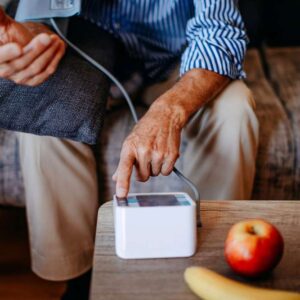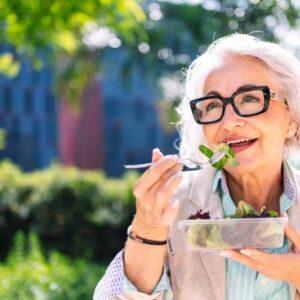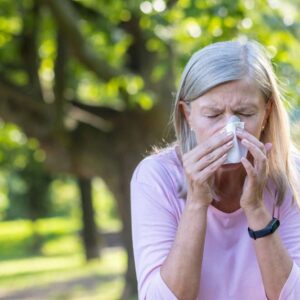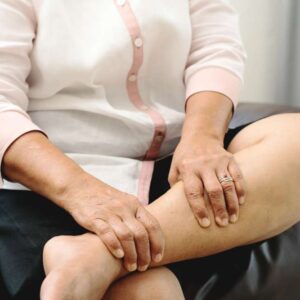
Fight Heart Disease, Cancer, and Diabetes This Halloween
Dear Reader,
In their most recent stats, the Centers for Disease Control (CDC) reports heart disease as the No. 1 killer in America.
And — I am sure it comes as no surprise that…
Cancer is No 2.
Then there is diabetes…
While diabetes is the seventh most prevalent killer in America, it’s among the fastest growing diseases in modern times.
Heart disease, cancer, and diabetes are scary because they can change your lifestyle entirely. Your life could be full of doctor visits, prescription drugs, uncomfortable treatments, and the worst part — limited freedom to live as you once did.
According to the Center for Disease Control, about 735,000 Americans have heart attacks annually. 210,000 of those were in people has already had at least one heart attack.
Note: Here at Living Well, we don’t always think the CDC is a credible source for healthcare information. However, it does provide the most reliable statistics for chronic disease prevalence and incidence.
Diabetes– the Gateway Disease
What’s even more alarming, heart disease and stroke are the No.1 cause of death for people with Type 2 diabetes. In fact, diabetes can double or even quadruple the chances of heart disease and stroke.
Diabetes is a chronic disease that can cause lifelong dependence on medications and in some cases, debilitating physical disabilities, including amputations.
America now has 29.1 million cases of diabetes. Of these cases, 11.8 million sufferers are over the age of 65.
In addition to increasing your chances of having heart disease, diabetes increases your chances of being diagnosed with cancer as well. A study has shown Type 1 and Type 2 diabetics are more susceptible to certain types of cancer (liver and pancreas, to name a couple).
Cancer in America is also on the rise. There are an estimated 1,658,370 new cases diagnosed in the U.S. for 2015. The estimated number of deaths from cancer in 2015 is 589,430.
Among diagnosed populations, people over age 65 make up over 56 percent of diagnoses and 70 percent of deaths.
Think of the people in your life who have been touched by one or all of these diseases, including yourself.
Even if you escape a cardiovascular ailment, cancer diagnosis, or diabetes yourself, chances are your loved ones have been or will be affected by it. Or worse — you have lost someone dear to these killers.
And what makes it more upsetting — there are ways to prevent heart disease , cancer , and diabetes.
It’s in Your Food
All of these diseases have one powerful thing in common — you can lower your risk by altering your diet.
Sounds easy enough, right?
But, where are you going to find a single food that will have positive effects for all of these diseases?
Well, there is a powerful cancer reducing, heart- protecting, and blood sugar regulating produce most Americans use for seasonal decor.
A gourd typically used for centerpieces, or porch accents, or carved into spooky faces for the entertainment of families.
That’s right. Pumpkin flesh is full of carotenoids.
What the heck is a carotenoid?
Carotenoids are the pigments found in pumpkins. In addition to providing pumpkins’ their vibrant orange hue, carotenoids are powerhouse antioxidants with abilities to hunt down free-radicals and stop the oxidation process. Consequently, pumpkin can help you fight off the signs of aging and the effects of cardiovascular disease and cancer.1
Pumpkin carotenoids include beta-carotene — a potent immunostimulant that helps regulate and stimulate immune responses, aids in the suppression of tumor progress, and can even halt cancer development.1
This means these powerful pigments have to the ability to steady your immune system’s activity to disease (lowering inflammation for example) and reduce the growth of tumors and interrupt the cancer progression.
Alpha-carotene, another carotenoid in pumpkins was the subject of a study that found it to be a very powerful anti-cancer agent and cardiovascular aid. The authors stated:
“Our findings, based on data from a large representative sample of U.S. adults, showed that serum alpha-carotene concentrations were inversely associated with the risk of death from all causes and death from cardiovascular disease (CVD), cancer, and all causes other than CVD and cancer. They also showed that the inverse association was independent of demographic characteristics, lifestyle habits, and traditional health risk factors.”
Simply put, incorporating foods with high levels of alpha-carotene, regardless of your lifestyle, increase your chances of a healthy life.
It just so happens, pumpkins yield some of the highest levels of alpha and beta carotenes. In fact, one half cup serving of pumpkin contains about 2 times the daily recommended dose of both.
Not to mention, it is a good source of dietary fiber. The same serving size yields 16 percent of your daily needs, making this filling food to add to incorporate into your diet. Dietary fiber is a great way lower insulin levels and regulate hunger.
But, the healthy benefits of pumpkin are not limited to just the flesh.
More Than Just a Seed
A study has shown pumpkin seeds contain trigonelline and nicotonic acid, these macromolecules have hypoglycemic qualities that could help maintain health blood sugar levels. Though more research is needed, these compounds may eventually be a viable treatment for diabetes.
Pumpkins seeds are a great source of magnesium. In fact, a quarter cup serving of pumpkin seeds has about half the daily recommended amount of magnesium.
This mineral is vital to insulin resistance. One study revealed that people with low levels of magnesium are more susceptible to Type 2 diabetes.
Zinc is another vital mineral for good health. With a quarter of the daily recommendations for zinc per serving, pumpkin seeds are a great source.
Zinc has long been used in early insulins. It is essential for breaking down of carbohydrates — which assists in blood sugar regulation 2.
Also, Zinc acts as a powerful antioxidant protecting cells from free radicals. And has been linked to immune health, and cell regeneration and one clinical trial showed zinc to be helpful in the treatment of major depression as well.
On the Table
Since canned foods are less healthy than fresh foods and can lead to BPA exposure, eating fresh pumpkin is a healthy choice for you and your family. And, of course, if organic whole pumpkins are an option, choose those.
One of the best uses is pumpkin puree. You can turn this into pies, sauces, or add it to soups for extra fiber.
Roasting a whole pumpkin is a simple feat. I found these instructions at detoxinista.com. I tried them on for myself and took pictures of the process. I hope they are helpful!
1. Preheat your oven to 350 degrees F.
2. Rinse off your pumpkin, and then use a knife to pierce the outside a few times, to allow for ventilation.
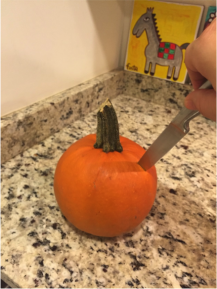
3. Place the whole pumpkin in a glass baking dish, and place in the oven to roast for 45-60 minutes, depending on the size of your pumpkin. The pumpkin is ready when the flesh has darkened and the skin is easily pierced with a fork.
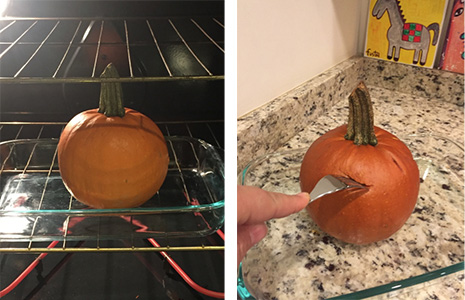
4. Cut the pumpkin in half, and allow to cool until safe to handle.
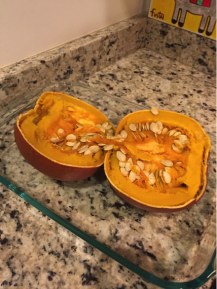
5. Use a large spoon to scrape out the seeds, and set them aside.
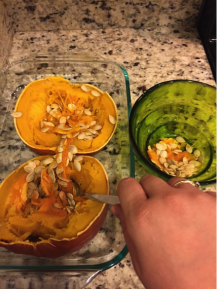
6. Remove the skin and put chucks of the cooked pumpkin into a food processor. Blend until a smooth puree is formed. Batches will work best if you have a larger pumpkin.
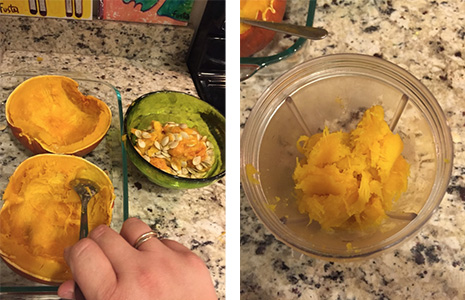
The puree can be will good for up to a week in the fridge and can be frozen for longer shelf life. It makes a great addition to soup and stew broths and adds a little sweetness to pasta or enchilada sauces.
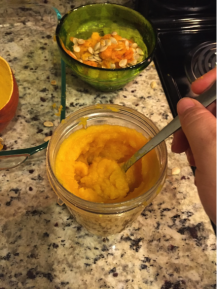
Pumpkin puree can also be a healthy addition to your pet’s diet. Packed with vitamins and fiber, a few tablespoons added to their regular food can aid in digestion and overall health. And, it’s natural flavor seems to appeal to dogs and cats. Just be sure you are feeding them pure pumpkin — no added sugars or spices.3
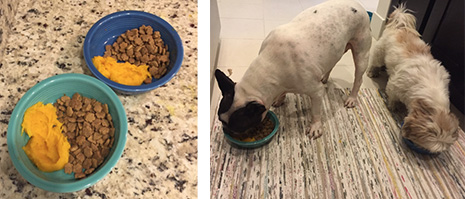
This in-house panel of experts agree that pumpkin is a welcome addition to pet meals.
As for the seeds…
I like to roast mine with turmeric and a little bit of sea salt. You can add any type of seasoning or spice to create a flavor combination of your liking.
Here is a basic recipe:
1. Preheat oven to 400 degrees F.
2. Rinse the seeds in a produce strainer, making sure to remove all pulp from the seeds and allow to drain.
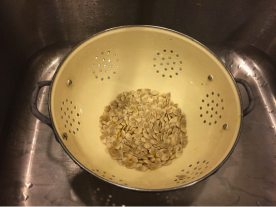
3. Place rinsed and drained seeds in a glass dish and toss with melted butter or your oil of preference until the seeds are fully coated.
4. Add spices and salt to taste and toss again.
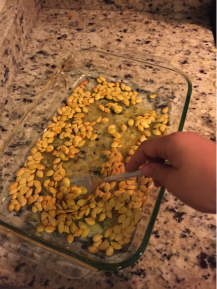
5. Lay seeds in a single layer on a baking sheet and place in the oven.
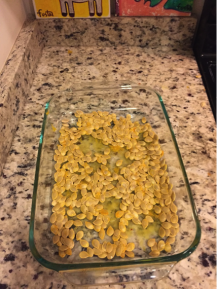
6. Roast for 45 minutes or until seeds start to brown, stirring occasionally.
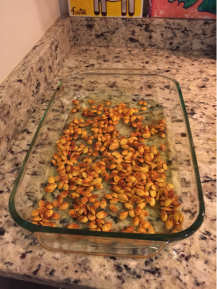
You can add these seeds to salads, soups, or baked goods, or just enjoy them alone as a snack.
If you have any health concerns you would like us to cover, we would love to hear your suggestions!
Live well,

Natalie Moore
Managing editor, Living Well Daily
Citations:
[3] The Health Benefits Pumpkin Provides for Our Pets
Written By Natalie Moore
Natalie Moore is a dedicated health researcher with a passion for finding healthy, natural, and science-based solutions. After a decade of direct healthcare experience in western and natural medicine, she was involved in public health research before joining Living Well Daily.
View More Free Articles
The 5 Health Numbers Your Doctor Wishes You'd Track
Have you ever been told you should “advocate” for yourself when it comes to your healthcare and wondered what that really means? It’s not just a buzzword—it’s a powerful concept that empowers you to take charge of your own health journey. In fact, it could save your life. Being your own best health advocate starts...
Do THIS Every 20 Minutes to STOP Digital Eye Strain
Our eyes are under assault—they are the true victims of our current digital age. And it’s because we are constantly glued to screens… phones, tablets, computers, TVs—you name it. Unfortunately, that screen time is taking a serious toll. Digital eye strain affects millions worldwide. In fact, up to 50 percent of computer users could develop...
Mailbag: The Calcium Mistake That's Hardening Your Arteries
“What type of calcium is best to take with bisphosphonates for osteoporosis? I know some varieties can build up in arteries. Thanks for the help.” —Bone Builder Hi Builder, When a patient asks me about calcium, I ask them a peculiar question in return… “Ever wonder how elephants and giraffes build and maintain their massive...
Doctor-Approved Method to Ditch Blood Pressure Meds
In a world where drug solutions dominate healthcare, it’s refreshing to discover that best remedies sometimes don’t involve a single pill. A groundbreaking study shows simple relaxation techniques could be your secret weapon against one of America’s deadliest health conditions. Best of all? It’s free, easy to start right away—and your results are bound to...
Trouble Hearing? Your Heart Could Be at Risk
With research exploding and data pouring in, scientists are uncovering some weird (and surprisingly helpful) health connections. Today’s odd couple? Hearing loss and heart failure. Turns out your ears and your ticker are more connected than you ever imagined. A major study published in the journal Heart looked at over 164,000 people for nearly a...
Stay Up Late? It Could Destroy Your Mental Health
If you dread mornings but come alive at night, there’s concerning new research you need to know about. A recent study found that “night owls” are at higher risk for depression. But before you rush to set your alarm to get up with the sun tomorrow, there’s more to the story… Chronotypes are essentially your...
Go from Flabby to Fit with this Common Vitamin
If you’re like many of us, you woke up one day, looked in the mirror, and realized you’re no spring chicken anymore. Even worse—when you weren’t paying attention—it seems you somehow misplaced the muscles of your youth and have gone from fit to flabby. Aging has a way of humbling us like that. But scientists...
Seasonal Allergy “Off Switch” Discovered in the GUT
“Doc, why am I suddenly suffering from seasonal allergies when I’ve never had them before?” It’s a question I get all the time—and my answer might surprise you. Stop looking up at the trees—and start looking down at your gut… Your sneezing fits, itchy eyes, and runny nose might have more to do with what’s...
“Canary in the Coal Mine” Test Sniffs Out Brain Issues Early
One of the most common questions I get is how to tell if you’re starting to experience cognitive decline. I get it—losing your memory is scary, especially when it sneaks up on you. But here’s some exciting news that might put your mind at ease. A fascinating new study suggests that your nose might be...
BEAT Stubborn Leg Swelling Without Dangerous Diuretics
“I need help with edema.” —Swollen Hi Swollen, When patients complain of edema—fluid retention that causes feet, ankles, and legs to swell—I explain that, while conventional medicine immediately prescribes diuretic drugs, nature offers us effective solutions we can try first. I’ll share those in just a moment, but first, let’s take a quick look at...
